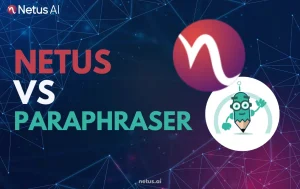
Netus vs. HumanizeAI | Netus.ai
Netus.ai vs. HumanizeAI: Which tool excels in AI bypassing, human-like rewriting or academic reliability? Dive into this detailed breakdown comparing features, accuracy or use cases.
How a Plagiarism Software Boosts Quality Content Creation: Expert Insights

Content writer and editor for Netus.AI
How a Plagiarism Software Boosts Quality Content Creation. Creating high-quality and unique content is crucial for any writer to convey their message effectively to the reader. With the ever-increasing importance placed on addressing plagiarism, it has become essential to verify the originality of one’s work before submission or publication. The use of plagiarism software helps ensure that the content remains authentic and maintains the writer’s credibility, trustworthiness, and integrity.
Not only does plagiarism hamper a writer’s career, but it also impacts the content’s original creator, who values their work and considers plagiarism a violation of their rights. Whether it is blog content or a school project, it is essential to practice ethical writing, keeping the content fresh and exclusive to maintain its essence and make it engaging for the readers.
Plagiarism is the unethical act of using someone else’s work without giving proper credit or presenting it as one’s own creation. It can occur in various forms and contexts, including research papers, school projects, and blogs. Different types of plagiarism include:
It’s important to understand that copying content from the internet still requires proper citation, as all pre-published articles, regardless of their origin, warrant proper attribution. Neglecting to cite sources for paraphrased content may also be perceived as plagiarism.
To prevent unintentional plagiarism, writers should use quotation marks when quoting directly from a source and provide citations for both direct quotes and paraphrased content. Accurately citing sources helps avoid copyright infringement and shows respect for the original creator’s ideas.
Students, writers, and professionals should utilize plagiarism detection software to identify any potential issues within their work. By doing so, they can protect their careers and maintain a reputation for producing original, high-quality content. It is crucial to always prioritize ethical writing practices and adhere to the guidelines set forth by institutions and copyright laws.
Plagiarism poses a significant risk to the careers of students, researchers, journalists, and bloggers alike. It is viewed as an unethical act by most institutions and can lead to serious ramifications for those who engage in it, even if it is accidental or unintentional plagiarism. Some of the possible consequences include:
To avoid these potential consequences and uphold high standards of integrity, it is critical for individuals in all fields to remain vigilant against plagiarism – both intentional and unintentional – and strive for original, well-cited work.
To avert plagiarism, writers can execute several key techniques. Firstly, they should immerse themselves in various articles on their topic of interest to gain comprehensive understanding. This can help simplify the subject matter by breaking it down into questions. By addressing these questions, a writer can create a well-rounded and consistent paper.
If a writer encounters difficulties in developing arguments, they may refer to portions of their source materials. It is essential to note down essential information about the parts they want to quote to ensure nothing is missed during citation. Misquoting can also be considered plagiarism, so accuracy is crucial.
Upon completing the writing and placing the quotes within quotation marks, writers should proceed with proper citation. There are diverse citation styles, including APA and Chicago, which should be implemented correctly. Authors must include comprehensive information about the source, such as the work’s title, author, publication date, page number, and other relevant details.
Lastly, using a grammar checker and a plagiarism checker is essential to identify any unintentional mistakes and ensure original content. These tools can help writers produce unique, well-crafted research papers while giving due credit to the original sources. By adhering to these best practices, journalists, freelance writers, and researchers can maintain a high level of originality in their work, supporting ethical and credible academic writing.
Plagiarism software is designed for detecting duplicate content in a document. Many online tools can quickly identify copied sections within an article. Before utilizing a plagiarism checker, it is beneficial to use a grammar and spell checker to enhance the software’s accuracy in generating results.
To use the software, writers simply need to upload their content onto the platform. The software then scans the uploaded work, comparing it to other articles available online. It accurately identifies any plagiarized sections and generates a detailed report, complete with percentages for each identified match.
Furthermore, the plagiarism software reveals the source articles, allowing writers and students to either cite these sources or remove the copied content altogether. This streamlined process ultimately helps individuals work on the identified plagiarized sections efficiently and produce unique, plagiarism-free content.
A diverse selection of plagiarism checkers is available, including Quetext, Grammarly, Scribbr, and Turnitin. These tools offer various features to accommodate users’ needs, including similarity scores, detailed reports, and different subscription models, ensuring a suitable solution for every user.
A plagiarism checker can be an excellent tool to enhance your writing by:
Plagiarism detection software offers numerous benefits, including:
Plagiarism software improves research writing quality by:
Codeleaks is a specific tool designed to detect:
In the context of academic writing, anti-plagiarism software is crucial because it:
Within educational platforms, such as Google Classroom, plagiarism detection integrates seamlessly to:

Netus.ai vs. HumanizeAI: Which tool excels in AI bypassing, human-like rewriting or academic reliability? Dive into this detailed breakdown comparing features, accuracy or use cases.

Netus.ai vs. BypassAI: Which tool excels in AI bypassing, human-like rewriting or academic reliability? Dive into this detailed breakdown comparing features, accuracy or use cases.

Netus.ai vs. AIUndetect: Which tool excels in AI bypassing, human-like rewriting or academic reliability? Dive into this detailed breakdown comparing features, accuracy or use cases.

Netus.ai vs. AIUndetect: Which tool excels in AI bypassing, human-like rewriting or academic reliability? Dive into this detailed breakdown comparing features, accuracy or use cases.

Netus.ai vs. Paraphraser: Which tool excels in AI bypassing, human-like rewriting or academic reliability? Dive into this detailed breakdown comparing features, accuracy or use cases.

Netus.ai vs. Smodin: Which tool excels in AI bypassing, human-like rewriting or academic reliability? Dive into this detailed breakdown comparing features, accuracy or use cases.
@ 2024 Netus AI.